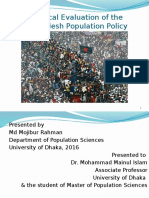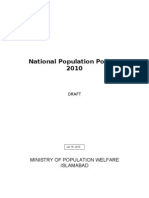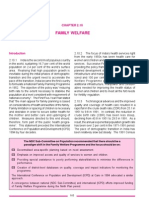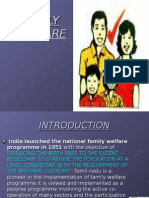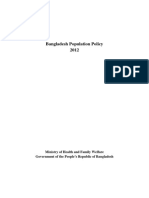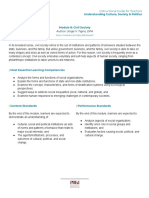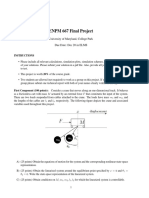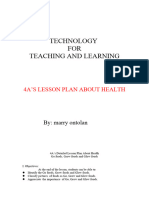Recent Shift in Bangladeshs Population Policy and
Uploaded by
jannatuladninj15Recent Shift in Bangladeshs Population Policy and
Uploaded by
jannatuladninj15See discussions, stats, and author profiles for this publication at: https://www.researchgate.
net/publication/242745958
Recent Shift in Bangladesh's Population Policy and Programme Strategies:
Prospects and Risks in Bangladesh
Article · January 2003
CITATIONS READS
9 2,034
2 authors, including:
Rifat Akhter
University of Central Arkansas
12 PUBLICATIONS 75 CITATIONS
SEE PROFILE
All content following this page was uploaded by Rifat Akhter on 30 June 2015.
The user has requested enhancement of the downloaded file.
CPD
Centre for
Policy Dialogue
Paper 5
RECENT SHIFT IN BANGLADESH’S POPULATION
POLICY AND PROGRAMME STRATEGIES:
PROSPECTS AND RISKS
Mohammed A. Mabud
Rifat Akhter
Price Tk. 50.00
Centre for Policy Dialogue
House No 40/C, Road No 11, Dhanmondi R/A, GPO Box 2129, Dhaka-1205, Bangladesh
Tel: 8124770, 017521580; E-mail: cpd@bdonline.com
Website: www.cpd-bangladesh.org
July, 2000
CPD-UNFPA Publication Series
It is now widely recognised that there is a need to take the scope of the population policy
in Bangladesh beyond the confines of achieving population stabilisation through
reduction of fertility. Although in recent years the approach to reduction of fertility has
changed from narrow family planning to a broad based reproductive health approach, it is
being increasingly felt that Bangladesh’s population policy should encompass other
equally important issues which have wide implications for the development process and
the quality of life of people of Bangladesh. To address some of the related pertinent
issues the Centre for Policy Dialogue has initiated a programme which aims at
undertaking a series of studies covering the broad area of Population and Sustainable
Development. The major objective of these studies is to enhance national capacity to
formulate and implement population and development policies and programmes in
Bangladesh, and through close interaction with the various stakeholder groups, to
promote advocacy on critical related issues. The programme which is scheduled to be
implemented by the CPD between 1999 and 2002 shall address, inter alia, such issues as
population dynamics and population momentum and their implications for education and
health services, the nexus between population correlates, poverty and environment,
impacts of urbanisation and slummisation and migration, as well as human rights. The
study has benefited from generous support provided by the United Nations Population
Fund (UNFPA). The programme also envisages organisation of workshops and dialogues
at divisional and national levels and also holding of international thematic conferences.
As part of the above mentioned CPD-UNFPA collaborative programme the CPD has
planned to bring out a series of publications in order to facilitate wider dissemination of
the findings of the various studies to be prepared under the aforementioned CPD-UNFPA
programme. The present paper on the theme of Recent Shift in Bangladesh’s Population
Policy and Programme Strategies: Prospects and Risks has been prepared by Dr.
Mohammed A. Mabud, Former Division Chief, Planning Commission, Government of
Bangladesh and Ms. Rifat Akhter, Assistant Professor, Population and Environment
Department, Independent University, Dhaka.
Assistant Editor: Ms Ayesha Banu, Coordinator (Dialogue & Communication), CPD
Series Editor: Professor Mustafizur Rahman, Research Director, CPD
CPD-UNFPA Paper 5
Acronyms
HPSP = Health and Population Sector Programme
NPC = National Population Council
MOHFW = Ministry of Health and Family Welfare
TFR = Total Fertility Rate
CBR = Crude Birth Rate
CDR = Crude Death Rate
ECNEC = Executive Committee of the National Economic Council
NIPORT = National Institute of Population Research and Training
NIPSOM = National Institute of Preventive and Social Medicine
FWC = Family Welfare Center
NRR = Net Productive Rate
STD = Sexually Transmitted Disease
ADP = Annual Development Programme
LGRD = Local Government and Rural Development
FWA = Family Welfare Assistant
EOC = Essential Obstretics Services
AOP = Annual Operational Plan
MCWC = Maternal and Child Welfare Center
ESP = Essential Service Package
IEC = Information Education and Communication
MCH = Maternal and Child Health
FWV = Family Welfare Visitor
CPR = Contraceptive Prevalence Rate
IUD = Intra Uterine Device
FWVTI = Family Welfare Visitors' Training Institute
HFWC = Health and Family Welfare Center
BCC = Behaviour Change Communication
MIS = Management Information System
Recent Shift in Population Policy and Programme Strategies i
CPD-UNFPA Paper 5
Table of Contents
Page
1. Introduction 1
2. Policy and Programme Review in Retrospect 2
3. Multi-sectoral Strategies and Progress 8
4. Debate on Policy and Programme Strategies 12
(a) Revisionist School of Thoughts 12
(b) Reformist School and Thoughts 13
5. Introduction of Health and Population Programme Strategy (HPSP)
and its Scope 14
6. Essential Service Package (ESP) 14
6.1 Reproductive Health Care 16
6.2 Child Health Care 20
6.3 Communicable Disease Control 21
6.4 Limited Curative Care 21
6.5 Behaviour Change Communication (BCC) 22
7. Common Grounds and Differences
between Revisionists and Reformists 23
8. Some Critical Lapses in HPSP 25
8.1 Lack of Multi and Inter Sectoral Approach 25
8.2 Demographic Momentum 27
8.3 Women's Development in Population Context 28
9. Policy Instrument 29
10. Prospects and Risks 29
10.1Risks 29
10.2 Prospects 31
11. Concluding Remarks 31
References 34
Recent Shift in Population Policy and Programme Strategies ii
CPD-UNFPA Paper 5
Recent Shift in Bangladesh's Population Policy and Program Strategies:
Prospects and Risks
1. Introduction
Since Bangladesh came into being in 1971, all successive Governments demonstrated
two things in common in respect of population policy planning, namely, their serious
concern about the rapid proliferation of human number and political commitment to solve
the problems arisen out of that. In a war ravaged country fraught with poverty and
massive illiteracy, the first such concern and commitment were shown by the
Government of Banghabandhu Sheikh Mujibur Rahman in 1973 which declared that the
population control and family planning activities were of national priority and that as a
policy response, most of the development ministries had to undertake appropriate
population activities in one form or the other befitting their scope and stride. The
population policy goal was set to reduce growth rate from 3.0 to 2.8 percent by the end of
the First Five Year Plan period (1973-78) and it was achieved. Multi-sectoral policy
strategies were also clearly laid out. Besides, true to its spirit and commitment,
Government had created a separate sector for "Population Planning" for effective
coordination, resource management and activity planning. It created a Population
Planning Division in the MOHFW to give an undivided attention to population issues and
intensify service delivery all over the country. It also laid an emphasis on human resource
and institutional development. The Government's serious concern for fertility control was
revealed in the following statement .
"No civilized measures will be too drastic to keep the population of
Bangladesh on the smaller side of 150 million for sheer ecological
viability and the nation has to be mobilized and early. The more this
mobilization is delayed, the more will be the possibility of attaining the
above objective by currently acceptable means recede. The first requisite
is the realisation of the gravity of the population problem at all levels of
political leadership and total commitment to its solution." (First FY Plan,
P.538).
Recent Shift in Population Policy and Programme Strategies 1
CPD-UNFPA Paper 5
The above thrust and emphasis on population activities continued until the introduction of
Health and Population Sector Programme (HPSP) in 1998. This change resulted into
several shifts in emphasis on population activities from the point of view of strategic
approach to the population problem. The central purpose of this paper is to discuss those
shifts and their prospects as well as risks. Keeping in view this purpose, the paper is
structured as follows: First in order is the review of the population policy and programme
in retrospect to highlight the success and failure followed by a discussion on the debate
that has emerged for introducing new policy and programme strategies through HPSP.
This is followed by some discussion on the major highlights of the HPSP with a view to
showing the shifts that differ from the previous policy strategies. Some common ground
between the old and new policy strategies are also identified and discussed. Based on the
analyses of the implementation experience of various stakeholders, some risks and
prospects are presented. Finally, the author makes some recommendations as to how risks
can be minimized in the current policy strategies.
2. Policy and Programme Review in Retrospect
The First Five Year Plan was the first population policy document which envisaged the
integration of Family Planning and Health Services which were parallel programme
activities as a legacy of the erstwhile Pakistani period and continued in an augmented
form until 1997. The Government adopted one population policy guideline in 1976 which
was followed until 1980. In fact, the population plans contained in the subsequent Five
Year Plans were the only population policy documents which guided the population
activities in Bangladesh. In pursuance of the First FY Plan policy strategy, the
Government tried to integrate Health and Family Planning Programme in 1974 but with
little success. During 1973-75, a good number of measures were taken such as:
introduction oral pill in the programme and registration of couples. Health facilities were
utilized to popularize sterilization and IUD programmes. In late 1975, erstwhile East
Pakistan Family Planning Board was converted into a Directorate of Family Planning and
put under the direct control of the Ministry of Health. The maternal and child health
(MCH) programme was also transferred to the newly created Directorate of Family
Planning. Since then, MCH-based family planning became the keystone of the service
Recent Shift in Population Policy and Programme Strategies 2
CPD-UNFPA Paper 5
delivery package and all logistics, infrastructure and supplies were geared towards this
end. The National Population Council (NPC) headed by the Head of the Government
was, for the first time, established; and the first Bangladesh Fertility Survey (BFS, 1975)
was conducted. Three important findings of this survey were: TFR was 6.3; CPR was 8.5
percent; and female age at first marriage was estimated to be 14.9 years.
The successor Government of Ziaur Rahman (1976-82) not only maintained the policy,
but also went one step ahead by declaring that the population problem was the nation's
number ONE PROBLEM. It put emphasis on service delivery and follow up care at the
doorstep. For this purpose, it deployed 13,500 matriculate female workers and 4500
whole time union level supervisors by replacing 30,000 part time village Dais with back-
up service by the technical staff like doctors and hundreds of paramedics all over the
country. Zia's Government bifurcated the Ministry of Health into Population and Health
Divisions and put one Minister exclusively in charge of Population Division to address
population issues with full attention. In 1976, the government approved a National
Population Policy guidelines involving various ministries and NGOs. The policy
contained both family planning and non-family planning measures such as (i) tax benefits
to unmarried and families with fewer children; (ii) preferential treatment in allotment of
housing, and giving medical benefits to individual with fewer children; (iii) credit and
economic benefits to the mothers' club, women's cooperatives and other organized
groups; (iv) liberalization of law relating to abortion, to cite a few. The central purpose
was to hasten the achievement of demographic goal of NRR=1 set for the year 1990,
much ahead of social changes, especially in respect of education, health, and women's
status simply by pursuing two strategies namely (i) accelerated service delivery at the
doorstep, and (ii) multi-sectoral approach to poise the society through intensive campaign
and services through organized sectors. The Government's in its desperate bid,
experimented a "5 Year Zero Population Growth" at Dhamrai - a suburb of Dhaka.
Despite four times larger per capita investment, the results of this experiment were far
from expectation and the project was abandoned in 1982. In fact, this new policy of 1976,
in spirit and many of its components, was the resonance of the previous policy and its
demographic goal of NRR=1 set for 1990 was no longer pursued as it was found to be
Recent Shift in Population Policy and Programme Strategies 3
CPD-UNFPA Paper 5
unachievable within this stipulated time. But efforts for service delivery were heavily
intensified through field workers and motivational campaign with all conceivable means.
Since 1976, family planning turned increasingly to be an MCH-based, multi-sectoral and
community-based-integrated programme. In order to provide MCH care and family
planning services from institutional set-up in rural areas, it was decided to establish
Family Welfare Centers (FWC) at the union level, and accordingly, as many as 79 (out of
80) FWCs were set up in pilot areas of five districts -Dhaka, Chittagong, Jessore,
Rangpur and Tangail during 1978-80. In addition, involvement of voluntary
organizations, social groups and religious leaders including youth and women was
increased to broaden the horizon of contraceptive practice through a social movement.
The integrated MCH and Family Planning Organization was extended from the national
level to all districts, Sub-divisions, Upazilas, Unions, Wards and Villages. Besides, a
supervisory tier was established at Divisional level with a view to decentralizing the
process of decision-making and follow up action.
In brief, a Director at the Divisional level; a Deputy Director and two Assistant Directors
at the District and a Family Planning Officer at the Upazila level were created. Besides, a
Medical Officer (MCH-FP) at the Upazila level was also created for technical
supervision. A Family Planning Assistant at the Union level (FPA) and a Family Welfare
Assistant (FWA) at the Ward level were appointed on full time basis. Besides, several
institutions were also established for manpower development. These were: (i) a college of
nursing, (ii) 12 family welfare visitors' training institutes and, (iii) eight Medical
Assistants' Training Institutions (MATIs).
During the tenure of Hussain Mohammed Ershad (1982-90), the population policy
strategies remained more or less the same as the previous governments. Ershad used to
hold National Population Council almost every month to monitor the progress of
implementation of population activities and gave necessary direction to the MOHFW and
other ministries involved in population activities. In fact, the programme during the 80's
entered into the 2nd phase. In early 1983, it confronted the most controversial issues viz
Recent Shift in Population Policy and Programme Strategies 4
CPD-UNFPA Paper 5
integration of health and family planning, and later on, "functional integration" was
rationalized to appease the rival groups in the programme. In the beginning, it may be
noted that "integration" was understood to mean basically integrating family planning
services with health and MCH with a view to making it more acceptable and more
effective by using a common delivery system. But those who opposed such integration
held the view that emphasis on population control and family planning would be lost, if it
is integrated with health service delivery system which was already weak and that
required priority would no longer remain. The underlying reasons for not being able to
integrate family planning with health was that the FP structure was a new one. It had
generated a built-in resistance to major changes and that despite various problems, this
separate arrangement was making progress. The "functional integration" as it was used to
be called was meant separating health and family planning into two separate structures,
but placing the two structures under one Minister and one Secretary as the head of
administration. In substance, two vertical wings namely, Health and Family Planning
joined at the top at the office of the Secretary of the Ministry and at the bottom by multi-
purpose village-based workers, but bifurcated at the Directorate, district and upazila
level.
A significant policy decision taken during the Second Five Year Plan (1980-85) was
regarding the fixing of the demographic goal to achieve a replacement level fertility in
1990. By implications, it means to reduce the crude birth rate from 43 per 1000 in 1980
to 32 per 1000 by 1985 implying a concomitant increase in contraceptive use rate from
14 percent to 38 percent during the plan period. While this demographic goal was too
ambitious, the decision to adopt such a high goal was governed by the consideration that
a ten years' delay in achievement of NRR=1 by 1990 would result in an increase of about
12 million population by the turn of the century. An additional 2.1 million tons of food
grain would need to maintain the current meager average per capita consumption of 16
ounces per day; and additional work force of 3.1 million, and increase in the number of
school going children by about 8 million. The social and economic costs of absorbing this
additional population will be enormous. Recognizing these realities, the Government felt
that the population policy strategy must aim at achieving a considerable decline in
Recent Shift in Population Policy and Programme Strategies 5
CPD-UNFPA Paper 5
fertility without any further delay. The implementation strategy to achieve the objectives
included strengthening health and family planning/MCH service delivery at upazila level
and below.
The third Five Year Plan (1985-90) was launched in the country with wide range of
policy, programmatic, social and motivational initiatives undertaken by both the GOB
and the NGOs with a view to achieving the demographic goals and programme targets.
The goals and targets of the plan were to reduce population growth rate from
approximately 2.4 percent in 1985 to 1.8 percent by 1990; to bring down infant mortality
rate from the prevailing rate of 125 per 1000 live births and to reduce maternal mortality
rate from 6 to 4 per 1000 live births. The contraceptive practice rate was planned to
increase from 25 percent to 40 percent by 1990. In order to achieve this goal, the
following strategic approaches were made:
a. Family Welfare Assistant registers were introduced for proper record-keeping of
acceptors, and monitoring the programme performance. This register is expected to
help improve local level planning and priorities for the different segments of eligible
couples for different services. A country wide couple registration system was
introduced to generate couples related data base.
b. Satellite clinics, twice a week, are being organized by FWVs from each Union Health
and Family Welfare Center to provide family planning and MCH services to the door-
step of the people. similarly, Medical Assistants (MAs) organized Satellite Clinics for
health education and other services.
c. On average, two sterilization camps from each of the 345 Upazila Health Complexes
were organized every month to take the service facilities nearer to the people.
d. Community level depo-holders for contraceptive distribution was organized from
amongst the female members of the Village Defence Parties (VDP) in the rural areas.
In addition 20 female VDP members belonging to one selected upazila of each
district (64) initially are being attached to each FWA.
e. Logistic Monitoring Teams identified problems relating to supply, storage and
distribution of contraceptives and other commodities. They also provided guidance
for proper maintenance of stores at central, regional and district level.
Recent Shift in Population Policy and Programme Strategies 6
CPD-UNFPA Paper 5
f. it was decided that in order to strengthen the IEC programme through Television, 25
minutes-attractive-programmes were telecast daily besides, Journalists were
encouraged to publish population related articles, stories etc. to create awareness of
small family norm.
g. Branch of National Population Council was set-up in each district under the
chairmanship of the District Coordinator. In this committee like the National
Population Control Council, people from all walks of life especially MPs, teachers,
doctors, political leaders, administrative heads of all government organizations etc.
were made members. But their functioning was moderate to low owing to lack of
leadership/initiative at the district.
h. Three Women's programmes were strengthened. In addition to project level regular
evaluations, three important studies were conducted namely, contraceptive prevalence
surveys in 1981, 83, 86 and 1989 (USAID), Bangladesh fertility Survey, 1989
(NIPORT), and Family Planning impact Survey at the District level by the PDEU,
1990 which provided a significant data base for the programmes.
During Begum Zia's tenure (1991-96), resource utilization was full and population
programmes made a considerable progress. At the beginning of the Fourth Five Year Plan
(1990-95) the population was estimated to be 114.2 million with a growth rate of about
2.16 percent, a crude birth rate (CBR) of 35.2 and crude death rate (CDR) of 13.6 per
1000 population. Total fertility rate (TFR) was estimated at 4.6. The 4th Plan document
stated: "if the present rate of population growth continues to be unchecked, Bangladesh is
expected to double its population by 2022 AD." At present, one out of every three
eligible couples is using contraceptives in comparison to one out of four during the
Second Plan. The Planning Commission observed that "in the MCH-based Family
Planning Programme where MCH component is vital for overall programme thrust, the
desired progress is slow". The Commission has further observed that NRR=1 could not
be achieved by the year 2000. It shifted this demographic goal upto 2005 (Ref: Chapter-
XII on Population Control and Family Planning in the Fourth Year Plan, 1990-95).
Recent Shift in Population Policy and Programme Strategies 7
CPD-UNFPA Paper 5
The core components of the National Family Planning Programme were:
a. Organization and Management
b. Logistics and Supplies;
c. Information, education and motivation;
d. Service Delivery including MCH; and
e. Management Information System.
These five components were brought together under the overall umbrella of the
Directorate of Family Planning headed by the Director General who was assisted by six
Directors and a Superintendent of the MCH Institute. The Directorate of Family Planning
is a permanent set-up operating through officers at 6 Divisions, 64 Districts and 464
Upazilas and they are borne out of the revenue budget of the Government. The Director
General, Family Planning (DGFP) as the Chief Programme-Manager administers the
programme through six Directors, each responsible for six field of activities, namely,
Service Delivery, Administration, MIS, Logistics and Supplies, Finance, Information,
Education and Motivation (IEM).
3. Multi-sectoral Strategies and Progress
During 1975-96, both political support and donors' assistance continued to remain strong.
The MCH-based family planning was the key essential service package. Multi-sectoral
strategies to combat the adverse effects of population growth and to poise the society for
small family norm were further strengthened. Several thousand rural family welfare
centers were established; and field works were intensified. Besides, quality of care
received utmost attention and population activities through other ministries were further
expanded and intensified. Much of the complications arisen out of clinical contraception
(e.g. IUD and Sterilization) was reduced to the international level of acceptance. Human
resource development at various level and research efforts were considerable. What is to
be acknowledged is that population policy measures adopted in mid-seventies remained
in force until 1997 when the present Government introduced new policy and programme
strategy under the rubric of "Health and Population Sector Programme (HPSP)." The
result of the previous population policy measures is a success story, as one can see the
Recent Shift in Population Policy and Programme Strategies 8
CPD-UNFPA Paper 5
marked improvement in several key demographic and programme indicators in the table
below:
Table 1: Progress of Population Programme from 1973-1996
by Few Selected Indicators
No. Indicators 1975 1985 1989-90 1996-97
1. Population (in million) 80.0 99.9 108.0 122
2. Population Growth Rate (%) 2.8 2.30 2.15 1.8
3. Crude Birth Rate (CBR) per 1000 46 36.0 33.5 27
population
4. Crude Death Rate (CDR) per 1000 18.0 13.0 12.0 9.0
population
5. Total Fertility Rate (TFR) 6.3 5.5 4.9 3.3
6. Infant Mortality Rate (IMR) per 140 112 94 77
1000 live birth
7. Maternal Mortality Rate (MMR) per 7.0 6.3 6.0 4.5
1000 live birth
8. Life Expectancy at birth (in years) 47 55 56.1 58
9. Contraceptive Prevalence Rate 8.5 25.0 39.0 48
(CPR) (%)
10. EPI Coverage Rate of Children - - 50.0 77
under 1 yr. (%)
Sources: i) Adapted from the Fifth Five Year Plan (1997-2002)
ii) Contraceptive Prevalence Survey, 1985
iii) Bangladesh Fertility Survey, NIPORT; Ministry of Health and Family Welfare, 1991.
In fact, during 1973-96 i.e. for long twenty three years, the population policy involving
various sectors of economy, initiated by the first Government remained as the key
guiding force. In 1973, there was only one programme viz family planning programme
which had several components, namely (i) an establishment of several hundred officers,
doctors and a large fleet of field workers including 30000 DAIS at the village level; (ii)
logistics; (iii) supplies and services; (iv) information, education and communication
(IEC); (v) training and (vi) research. But some of these components were turned to be
Recent Shift in Population Policy and Programme Strategies 9
CPD-UNFPA Paper 5
rudimentary when the size of the acceptors started increasing year after year. Some
strategic approaches had to be clearly laid out in the successive Five Year Plans with
clear-cut policy objectives and an ambitious demographic goal. As a result, each of the
above components was turned to be a big programme supported or reinforced by a
number of technical projects. The number of projects/programmes ranged from 32-40
during 1975-80 to 50-65 during 1980-85. In 1995-96, the number of projects came down
to 42 in the Population Sector. Almost two-third of the projects/programmes were
implemented by the Ministry of Health and Family Welfare, while one-third by other
Ministries such as (i) Ministries of Education, (ii) Information, (iii) Local Government,
Cooperatives and Rural Development, (iv) Agriculture, (v) Labour and Employment, (vi)
Social Welfare, (vii) Women Affairs, (viii) Religious Affairs, (ix) Youth and Sports and
(x) Ministry of Planning/Planning Commission. The nature of participation of these
ministries was in the form of (i) training and orientation of their own personnel in
population activities, (ii) utilizing their trained personnel for motivation of their target
population, and (iii) integration of population and MCH components into their activities
and training curricula. In fact, skill training, credit facilities and MCH-based population
education, use of mass media, population census and programme evaluation were the
main features of multi-sectoral population programmes. About one-fifth of the total
investment used to be spent for multi-sectoral population activities. While four-fifth was
spent for population projects/programmes under the Ministry of Health and Family
Welfare.
An examination of the data in Table I shows that investment in population sector during
1985-1997 gave promising results and brought hope to various stakeholders. Initial
progress was slow, but steady. There was linear increase in achievement in ever
indicators. Entire investment was, as if, directed towards social mobilization, human
resource and infrastructure development. When the society was poised and a reasonable
ground was prepared through the concerted efforts of the stakeholders, civil society, large
number of field workers and use of mass media, including Radio and TV, faster decline
in fertility1 and moderate decline in mortality2 started especially infant mortality and
1
Total fertility rate was reduced from 1990 level of 4.9 to 3.3 in 1996-97.
Recent Shift in Population Policy and Programme Strategies 10
CPD-UNFPA Paper 5
improvement in contraceptive prevalence rate (CPR) and life expectancy at birth from
1985 onward. Notwithstanding low socio-economic development, massive illiteracy and
wide-spread poverty, progress in terms of fertility decline and increase in CPR was
spectacular during 1990-97 (see Table-1). Although policy was prepared in the country,
policy-ideas, sometimes, came from the donors who were also the participants in policy
planning and implementation. Apart from the Government, donors especially the World
Bank has been a major player in the population field since 1973 till to-date. In fact, their
financial and technical assistance played a great role for the success of Bangladesh's
population policy and programmes during the entire period of 1973-97.
In brief, the population policy during 1973-97 was characterized by (i) multisectoral
approach involving many agencies/sectors, (ii) a separate "Population Planning" sector of
the economy for better resource management and activities planning, (iii) deployment of
a large fleet of matriculate female field workers for door step service delivery, (iv)
establishment of 3200 family welfare centers at the Union, 12 FWVTI's and a National
Institute of Population Research and Training (NIPORT) and (v) implementation of a mix
of programme and projects approach, (vi) integration of population/MCH component
with women activities of the BRDB, Rural Social Service Programme (RSS) of Social
Welfare Directorate and Vocational Training Programme of the Women Affairs
Department and (vii) effective use of mass media especially Radio and TV, and (viii)
Regular undertaking of demographic surveys, programme evaluation and three decinnial
censuses (1972, 1981 and 1991). Though Bangladesh was extremely in low profile on
development scale, it has, however, earned a great reputation for its remarkable
achievement made through credible implementation of its population policy and
programmes especially after 1985. It was expected that this policy would continue up to
2005-the year set for achieving the NRR-1 as the performance trends clearly showed that
the demographic goal would be achievable by then, if the policy could remain
uninterrupted. Coinciding with the end of the GOB's Fourth Five Year Plan (1991-95),
the World Bank-led 4th Population and Health Project also ended. Later on, tenure of both
the GOB's Fourth Plan and World Bank's 4th Population and Health Project was extended
2
CDR was reduced from 1990 level of l2 to 9 per 1000 population in 1998-97.
Recent Shift in Population Policy and Programme Strategies 11
CPD-UNFPA Paper 5
for two years (1995-97). This intervening period gave a window of opportunity to review
the then-policies and programmes which generated many new thoughts and holistic ideas
deliberated in many workshops and seminars. This lag period saw the emergence of two
schools of thoughts -"Revisionist" and "Reformist".
4. Debate on Policy and Programme Strategies
(a) The Revisionist School of thought held the view that the population policy already
stood the test of time and that any abrupt change without testing the new policy strategies
might paralyze the system that gave expected results in terms of reduction in fertility and
infant mortality as well as raising contraceptive prevalence rate and improvement in
quality of service. It also strongly advocated for maintaining .the doorstep service and
integrating population, reproductive health, nutrition, HIV/AIDS into the programmes
and policies of other sectors of the economy. It argued that support of other sectors,
though cannot be measured in demographic terms, would be extremely helpful in creating
an enabling environment for achieving the demographic goals and social objectives of
Health and Population Plan as well as for reaching the millions of residual population
who always remain outside the purview of the MOHFW owing to their occupational
belonging and vocational variations. It also argued for reducing the number of projects
and retaining the objective-oriented programmes only for better efficiency and
accountability within the framework of Annual Development Programme (ADB). It
argued integration of Health and Family Planning services at thana level and below and
strengthening existing service delivery units at all level as well as strengthening the
existing multi-sectoral population programmes including the three women's programmes,
namely, (i) use of women's vocational training for population activities, (ii) use of
Mothers' centers for population activities of the Department of Social Welfare; and (iii)
Use of Women's Cooperatives for population activities for the Bangladesh Rural
Development Board (BRDB) adding in those programmes components like HIV/AIDS,
and STD, and Nutrition. The revisionist school wanted to extend the activities to the other
sectors which were hitherto remained non-participant in population and health activities
and introduce reforms in hospital management and cost sharing in health services at the
hospitals and established institutions. They suggested that HPSP should be implemented
Recent Shift in Population Policy and Programme Strategies 12
CPD-UNFPA Paper 5
in phases and not in the whole country in a single go as it might create problem for the
providers and beneficiaries. They also urge that population policy must be redesigned to
take into account the adverse effects of several emerging problems, such as; (a)
increasing malnutrition; (b) peoples' health hazard owing to arsenic contamination; (c)
rapid increase in adolescent girls and their high fertility; and (d) environmental
degradation affecting people; (e) imbalance in the spatial distribution of population; and
(f) growing size of labour force and unemployed population. The Population Policy
should be responsive in the sense that it must seek to ameliorate the adverse effects of
these emerging problems.
(b) The Reformist School of Thought represents the MOHFW and some development
partners, especially the World Bank. They argued for a sector-wide approach in which it
is assumed that resources available through revenue and development budget be taken
into consideration for the entire gamut of health and population activities. According to
them, earlier progress was slow and could not reduce substantially the maternal and
infant death which is largely owing to lack of health orientation of the policy itself and
that time had come to shift the policy strategies towards sector-programme approach
rather than the multiple project approach. All health and population activities are brought
under one mega-programme called Health and Population Sector Programme (HPSP).
Only this programme is included in the ADP, but its various components such as
logistics, IEM, service delivery etc. will not be reflected there. There will be an Annual
Operational Plan (AOP) showing implementable activities and budget. The AOP will be
prepared by the line-directors who will submit it to the MOHFW for clearance by two
inter-ministerial Steering Committees -one is headed by the Secretary and the other by
the Minister of Health and Family Welfare. The former steering committee is a
recommending body; and while the latter holds the approving authority. The advantage of
this approach is that different line-directors need not have to run to the Ministry of
Finance and Planning Commission for release of fund or approval of the new project(s)
or revised unapproved project(s). In their view, sector-wide management is a time-saving
device, efficient and cost-effective. This School of thoughts proposed several reform
measures such as:
Recent Shift in Population Policy and Programme Strategies 13
CPD-UNFPA Paper 5
(i) Privatization of hospital services;
(ii) Pricing the service-cost at certain level;
(iii) Decentralization of service delivery;
(iv) Service Delivery under one unified command at the level of Thana and below; and
(v) There should be one stop service system in stead of door -step service delivery.
(vi) Introduction of a broad package of services which, to use their own term is called
"Essential Package of Services (ESP)" .The service delivery should be through
integrated approach, particularly at the Thana level and below.
5. Introduction of HPSP and its Scope
For the sake of clarity, a working definition has been provided in the HPSP (p. 15). In the
context of Bangladesh, the health and population sector is taken to include those activities
relating to the promotion and restoration of health to the population, including activities
to promote family planning and reproductive health. In true sector approach, this includes
all activities which fall under the remit of the Ministry of Health and Family Welfare
(MOHFW), as well as health services provided by other agencies such as Ministry of
Social Welfare, Local authorities, urban councils, communities, Non Government
Organizations (NGOs) and the private sector. It excludes, however, aspects which are
handled by different branches of Government other than MOHFW and are quite different
in scope, such as population censuses, female education or migration policy. Similarly, it
excludes other activities which impinge on health status such as provision of safe water.
But for the sake of HPSP, the sector includes all activities that are provided by the
MOHFW and the NGOs. This definition reflects the sector boundaries, which are implicit
in the Health and Population Sector Programme (HPSP) Strategy. Thus it is referred to as
the "health and population sector", while recognizing that certain activities which have an
impact on health and population are not covered.
6. Essential Service Package (ESP)
One of the key features of new health and population policy is the introduction of
Essential Service Package (ESP) which aims at maximizing health benefits relative to per
capita expenditure, meet felt needs of the clients, strengthen service delivery, and
Recent Shift in Population Policy and Programme Strategies 14
CPD-UNFPA Paper 5
improve system management. The Government currently provides many elements of the
Essential Service Package through the Directorates of Health and Family Planning.
However, with the increasing cost of health care, the Government has to focus on the
ESP which consists of the following five major areas:
¢ Reproductive Health Care;
¢ Child health Care;
¢ Communicable Disease Control;
¢ Limited Curative Care; and
¢ Behaviour Change Communication.
Due to resource constraints intended increases in the coverage, quality and accessibility
of the ESP will not be immediately feasible. A prioritization exercise was done to
identify the potential interventions and those that need to be included in the first year.
The "Reformist" argued that for efficient delivery of ESP, reforms in service structure at
three tiers would be necessary. First, actual restructuring of the central level (Secretariat
and the Directorates) is to be completed by year 2000. Second, restructuring at the thana
level and below where the ESP delivery will be through an unified structure comprising
health and family planning workers under a single manager who will be responsible for
the overall management and administration of all activities including:
(a) writing the Annual Confidential Reports (ACR) of the officers and the staffs at the
thana level, and
(b) as drawing/disbursing officer
The third restructuring will be at the community level where the services will be provided
from a fixed Centre, namely 'community clinic'. This is a significant shift from the
existing domiciliary-based service delivery system. The main principle in establishing
these community clinics is to make these as centers with community involvement through
their initiation in maintaining and providing the requisite security. The need for one-stop
service delivery and follow up visits for dropouts and/or special target group have been
Recent Shift in Population Policy and Programme Strategies 15
CPD-UNFPA Paper 5
taken consideration. The following discussion will illustrate various components of ESP
as mentioned above.
6.1 Reproductive Health Care
These are the services that aim at safe pregnancy and delivery, including fertility
regulation and treatment of abortions, avoiding unwanted pregnancies and postpone
births. It also includes reproductive morbidity and mortality, including STD/HIV, and
other aspects of sexual and reproductive health among adults and adolescents. To date
there has been insufficient attention given to maternal care and although the physical
infrastructure is in place, the concepts of the Safe Motherhood Initiative and the provision
of Essential Obstetric Care (EOC) have only been implemented on a limited scale. The
Essential Services Package will provide increasingly sophisticated services at each level
of the system, with a capacity to perform cesarean sections at specified Thana Health
Complexes (THCs), MCWCs and all district hospitals. During FPHP period (1991-1997),
under different projects, namely, MCH Strengthening Services (FP Directorate), EOC
(UNICEF assisted and OBGN Society implemented), TFIPP and Maternal and Neonatal
Health Care Pilot, 86 thanas and 47 MCWCs were strengthened to provide
Comprehensive Obstetric Care (with provision for Cesarean Section). However, the
strengthening was not uniform in all thanas. During the first year of HPSP, in addition to
further strengthening in these thanas, 35 more thanas and 18 MCWCs will be functionally
equipped to provide Comprehensive EOC. In the meanwhile, the rest of thanas will be
strengthened to provide the Basic EOC.
Interventions aimed at fertility reduction will continue but strategically focus on delaying
the age of first birth, improving continuation rates and improving quality of surgical
contraception. This will require complementary actions in other sectors to attain, e.g.
female education, employment generation and empowerment of women. The broad
categories of reproductive health care are:
Recent Shift in Population Policy and Programme Strategies 16
CPD-UNFPA Paper 5
¢ Safe Motherhood
¢ Family planning
¢ Prevention and control of RTI/STD/AIDS
¢ Maternal nutrition
¢ Unsafe Abortion
¢ Adolescent care
¢ Infertility
¢ Neo-natal care
(a) Safe Motherhood will focus on creating, in the health facilities as well as the
community, the necessary conditions for preventing maternal death and disability. The
focus will be on increasing utilization of EOC services. For this purpose, EOC will be
decentralized together with mobilizing communities. Antenatal care, safe birth practices
and postnatal care will also be emphasized. This component has the provision for FP
services, particularly for preventing unsafe abortions and the resulting death and
disability. Health facilities will be improved to make them women friendly and provide
services related to violence against women (both curative and counseling) along with
emergency transportation.
While at the thana and below the overall services will be provided under a single
management. As a transitional process, technical back-up management will be provided
by the directorates. The overall functions of safe motherhood have been divided between
the Health and Family Planning Directorates. At the community level, till to date the
TBAs are the only linkage to assure safe delivery, but existing evaluation suggests that
this has not improved the situation significantly. There are suggestions for the need for a
cadre of community midwives to ensure safe birth practices and prompt referral of
obstetric emergencies. However, it is planned to train the FWA and female HAs for 24
weeks on basic EOC and through the community clinic they will be able to provide the
obstetric first aid with normal delivery care closest to the community.
Recent Shift in Population Policy and Programme Strategies 17
CPD-UNFPA Paper 5
(b) Family Planning Service is an important means to achieve the country's goal of
NRR=2 by year 2005. The attainment of this goal will require introducing some strategic
changes. The most important strategy is to consider the FP activities as integral part of
Reproductive Health Care and accordingly, implement this re-conceptualizing process.
While the basic strategy will be to increase overall CPR of modern methods; other
strategies would be to reduce discontinuation rate of different contraceptives and to
encourage gradual transition of acceptors to long acting and permanent methods. A third
strategy will be to improve family planning services, for which improved management
skills will be ensured at all levels particularly in low performing areas and for under -
served groups. A fourth set of strategies will focus to increase skill manpower, improved
logistic supply, appropriate follow-up with supportive supervision and monitoring, and
improved management of side effects and complications.
(c) For Prevention and Control of RTI/STD/AIDS, the main focus will be on BCC and
condom promotion. In addition, the Government has identified syndromic management
for men and women with appropriate referral services as a strategy. The component of
prevention and control of RTI/STD/AIDS under the reproductive health care reflect those
intervention targeted for women within the 15-49 years age groups.
(d) Menstrual Regulation (MR) and Unsafe Abortion: Existing information suggests that
each year about 2.8% of all pregnancies undergo MR and about 1.5% undergoes induced
abortion. A significant amount of these are conducted in the public facilities, but under
unsafe conditions. Although significant number of doctors and paramedics (about 12,000)
received formal training in MR, and rate of complications and side effects have been
reduced over time, still unsafe termination of pregnancies mostly occurs due to
inadequate trained personnel and logistic support. In addition, many women do not know
of a provider or are not aware of time limits and access to legal MR services, especially
in rural areas. These also contributed to the factors related to unsafe abortion and MR
causing avoidable morbidity and mortality.
Recent Shift in Population Policy and Programme Strategies 18
CPD-UNFPA Paper 5
(e) Adolescent Care: Adolescents in Bangladesh, both male and female, constitute about
a quarter of the total population. Son preference and low status of women are affecting
girl adolescents' nutrition, education and access to health care. Early marriage and early
matrimony affect their overall health status. Only when they are married, the adolescent
girls get maternal care or family planning services; unmarried adolescents may not have
access to health care of any kind. Specific BCC messages will be addressed to
adolescents for:
¢ Proper nutrition and hygienic practices
¢ Information about puberty, safer sexual behaviour and how to avoid health
risks including STD/HIV/AIDS.
(f) Infertility: Infertility is considered to be a considerable reproductive health problem.
Infertility, primary or secondary is generally a medical problem requiring medical
investigation and treatment. RTIs in general and STDs in particular are the major causes
of preventable infertility. Sexually transmitted infection is now considered to be the most
common STD, causing pelvic inflammation leading to infertility. Interventions proposed
to improve the current status are:
(a) to educate both husbands and wives about the factors contributing to infertility ; and
(b) to prevent secondary infertility, through (i) Prevention and treatment of STDs/RTls;
(ii) Safe abortion services; and (iii) Safe delivery and post natal care
(g) Neo-natal Care: The services that will be mainly at domiciliary and union levels
include the following education, motivational and health care:
¢ Health education for mothers on cleanliness.
¢ Umbilical cord care
¢ Breast-feeding
¢ Thermal control
¢ Management of birth asphyxia
¢ Routine eye prophylactics
¢ Special care of pre-term and low birth weight babies
Recent Shift in Population Policy and Programme Strategies 19
CPD-UNFPA Paper 5
6.2 Child Health Care
(a) Child Health Care encompasses basic preventative and curative care for infants and
children. The GOB has implemented control programmes for Acute Respiratory Infection
(ARI), Diarrhoeal Diseases, Vaccine-Preventable Diseases *EPI) and Prevention of
Vitamin A Deficiency disorders. While there have been decline in child mortality from
all causes in Bangladesh, many children still do not have access to preventive and
curative services delivered by trained health workers.
These situations, therefore, indicate a need for an integrated approach to managing sick
children and for child health programmes that go beyond single diseases in order to
address the overall health of a child. Integrated Management of Childhood Illness (IMCI)
is a child survival strategy directed at improving prevention and case management of the
five major diseases measles, malaria, malnutrition, diarrhoea and bacterial pneumonia
which are responsible for about 70% of all mortality in children under 5 years of age.
(b) Immunization: Hepatitis B immunization of infants and Td (Tetanus-diphtheria)
immunization of school age children will be considered for inclusion in EPI programme.
Existing estimates show that HB immunization can potentially save 22,000 lives annually
at a cost of US $ 25 per year of life saved. The immunization of school age children
would protect children against tetanus and diphtheria and would advance future mothers
towards completion of a 5-doses TT schedule to confer life-long immunity against
tetanus.
(c) Malnutrition: It is the major factor that has been referred to as key compounding
factor for infant and child mortality. Nutritional status of children and adolescents not
only affects the present generation but also the future one. Chronic energy deficiency,
protein energy malnutrition, low birth weight, micronutrient deficiency are all serious
health problems in Bangladesh. Improper breast-feeding and weaning practices are
aggravated by the current situation of poverty, gender discrimination and inadequate food
security.
Recent Shift in Population Policy and Programme Strategies 20
CPD-UNFPA Paper 5
(d) School Health Services: School health services include training of school teachers for
providing first aid to the school students and provision of a First Aid Box in every school.
At least one school teacher will be trained for this purpose. The Medical Officer in THC
responsible for disease control will visit schools to conduct health check-up of school
children. Trained teachers may also identify students who need to be referred for
examination and treatment for any major illness or infirmity in THC/District hospitals.
Teachers will provide Health Education to the students mainly on hygienic practices,
communicable disease control and on life skills to prepare for adulthood. This will
include information on reproductive health including family planning and raising
awareness of STD/HIV/AIDS, and also identification of illness among students and
referral.
6.3 Communicable Disease Control
(a) Major interventions will include prevention and effective management of
communicable diseases with a severe health impact, e.g. TB, Leprosy, malaria, filaria,
kala-zar, intestinal parasites, STDs/RTIs, including HIV/AIDS and other emerging and
re-emerging diseases. The estimated incidence of pulmonary sputum smear positive
tuberculosis is about 111/100,000 population and the estimated incidence of total TB
cases (inclusive of sputum negative and extra-pulmonary cases) is about double the
sputum positive cases.
(b) For vector-bone diseases, particularly malaria and kala-azar the accepted Strategy for
Early Diagnosis & Prompt Treatment (EDPT) will be strengthened. For control of
filariasis, WHO recommends annual chemotherapy along with deforming for intestinal
infestations of parasites. A pilot study will be conducted to determine the most effective
regimen under this strategy.
6.4 Limited Curative Care
Care for common conditions and injuries must be provided because an Essential Service
Package has to meet the public expectations for these services. Government resources are
needed to provide basic first aid, treatment of medical emergencies, pain relief and
Recent Shift in Population Policy and Programme Strategies 21
CPD-UNFPA Paper 5
advice. Such services are especially important for the poor. The resources available will
limit the amount of service provided. However, economic evaluation of limited curative
care would be incorporated into overall cost-effectiveness prioritization of ESP
components in the future years of the HPSP. For the first year, provision of funds has
been made for basic first aid, management of medical and surgical emergencies at the
community, HFWC and THC levels. The most common disease like -asthma, skin
diseases, eye, dental, and ear diseases of infectious nature are also included. The first year
operational plan is given in Annex 8.1.4 along with the child health component.
6.5 Behaviour Change Communication (BCC)
BCC is a cross cutting intervention conceptualized to capitalize on the opportunities of
the rapidly expanding communication networks in Bangladesh. The emphasis is on multi-
media, multi-channel, inter-sectoral approaches based on systematic planning process to
produce innovative communication and creative strategies.
The primary aim of the BCC component is to shift health and family planning service
provision from a sectoral and provider-based system to an inter-sectoral, client-oriented,
demand-based system emphasizing community and women's empowerment with a focus
on social and gender issues, elderly and the poor. Target client will understand their need
for, and entitlement to, the Essential Service Package and demand them. The BCC
component aims at:
¢ Changing attitudes and behaviour of people to improve their health status;
¢ Building effective community support for health seeking behaviour;
¢ Changing attitudes and behaviour of service providers to provide client
centered services;
¢ Promoting men's respect for the special situation of the women and the girl
child in the society.
The six promotional strategies implicit in the BCC component are:
¢ Social Change -to address the issue of familial support to women and children
especially the girl child;
Recent Shift in Population Policy and Programme Strategies 22
CPD-UNFPA Paper 5
¢ Social Ownership -to trigger positive and practical approaches to ownership of
service delivery networks by the society;
¢ Provider Relations -to shift provider attitudes and practices towards a client
oriented and inter-sectoral approach to service delivery;
¢ Advocacy -to gain concurrence and support from the community at large,
including the social and political system, community and religious leaders,
and the mass media. Advocacy will be carried out to ensure partnership of the
non-health sectors, particularly the Ministries of Information, Education,
Religious Affairs, LGRD(DPHE), NGOs and corporate entities.
¢ ESP Intervention promotions -the promotion of the Essential Services
Package with an emphasis on demand generation and addressing the social
and gender issues that Impede the take-up of practices by women, mothers
and adolescents.
¢ Social Marketing will integrate the social, gender and behavioural-change
messages into existing programmes in order to sensitize men for those aspects.
7. Common Ground and Differences
(a) Both "Revisionist" and "Reformist" Schools of thoughts have many things in
common. First, both the schools of thought agree that decentralization of authority all the
way down is a sine qua non for overcoming the bottlenecks that impede the process of
decision making by the functionaries who are close to the people, transparency and good
governance. The size of the Ministry, according to them, should be reduced and much of
its functions should be delegated to the Directorates and the Directorates, in turn,
delegate some of its functions to the district and so on. The MOHFW should devote itself
in (i) policy planning, (ii) regulatory functions and (iii) research, monitoring and
evaluation. Secondly, both agree to reduce the number of projects to several thematic
programmes for efficient management; Thirdly, both the schools agree to have integrated
health and family planning services at the thana level and below under one unified
command for economy of scale; and Lastly, both strongly believe in decentralized
practices, and community participation in health and population activities.
Recent Shift in Population Policy and Programme Strategies 23
CPD-UNFPA Paper 5
(b) Notwithstanding the common ground, both have many subtle and strong differences.
First, Revisionist School feels that integration of Health and Family Planning should be
experimented in one or two districts and based on experimental results, it could be
expanded in phases throughout Bangladesh over a period of five years. The Reformist
School holds the view that integration should proceed with a single go and that
experimentation is unnecessary as it will delay the process of integration. Secondly,
"Revisionist School" feels that all thematic programmes, about 14 to 16, could be
included in the Annual Development Programme (ADP) for better accountability and
monitoring the programme activities, goal(s) and resource allocation. On the country, the
Reformist School holds the view that all components of the Health and Population Sector
should be brought into one mega programme, under the rubric of Health and Population
Sector Programme (HPSP) and that only this will be included in the ADP for better intra-
components-resource-management and overcoming the delays in meeting the complex
process of approval. It also argues that both health and population sectors should be
converted into a single sector which is contrary to the notion of the Revisionists that such
a conversion is uncalled for and undermine the importance attached to the "Population
Planning and priority", it has been enjoying since 1973. Thirdly, the Revisionist School
holds the view that inter-sectoral programmes should be broadened to include health
issues, HIV/AIDS, nutrition, arsenic and remain as an important part of sector financing.
Some of the inter -sectoral programmes now exist are too thin both from the point of
view of investment and coverage of population. Both the GOB and other donors should
also directly participation in inter -sectoral activities. The Reformist School excludes it
altogether and holds the view that HPSP would confine itself within the MOHFW,
although it admits that outcome of the programmes of other sectors of the economy may
affect the outcome of the HPSP. Lastly, the Reformists converse both revenue and
development into a single budgetary system for programming the activities -a new system
in which revisionist finds no real benefits.
Arguably, Revisionists stand for cautious move as they believe that social change should
not precede any scientific experimentation and that any good and sustained results can be
achieved by initiating changes, modifications or even some reforms within the system as
Recent Shift in Population Policy and Programme Strategies 24
CPD-UNFPA Paper 5
long as it is appreciated and understood by all stakeholders and also, it should be
designed to yield greater goods for the greater number of people in the Society;
Reformists, on the other hand, stand for quick fix and see that socalled revisions and
modifications of the on-going system will never bring about the desired results without
reforms; and hence, there is an element of urgency, especially in Bangladesh where
things move too slow. The debate on policy issues officially was settled, when the HPSP
was approved by the Government in May, 1998. But the question still looms large
whether such abrupt action was right! The Reformists ideas appear to be too attractive for
consideration. Many reform proposals contained in the HPSP are welfare oriented and its
service delivery package is much more substantial than the preceding one. There,
however, still remains serious apprehension regarding the implementation of various
components of HPSP, because those who are appointed to implement them at various
tiers were neither fully familiar with its contents nor the skills and necessary training -
things which are prerequisites for any new programme.
8. Some Critical Lapses in HPSP
Notwithstanding the enchantment of reform appeals, the HPSP has committed quite a few
lapses for which creation of enabling environment for achieving its various objectives is
rendered difficult. These lapses are: (i) HPSP does not provide for other sectors'
participation in Population, Health, HIV/AIDS and Nutrition etc.; (ii) it underestimates or
excludes measures for minimizing population momentum effect; and (iii) role of three
women's programmes of BRDB, Social Welfare and Women Affairs Departments in
Population, Health, HIV/AIDS etc. was excluded. The discussion that follows illustrate
these three basic lapses which, according to the Revisionist Schools will impede the
prospects of achieving the objectives of HPSP and the 5th plan's objectives for Health and
Population Sector.
8.1 Lack of Multi and Inter Sectoral Approach
In the Health and Population Sector, demographic momentum, deteriorating health status
and ever increasing size of severely malnourished population are, among others, major
problems having the gravest consequences on society and economy. The-sources of these
Recent Shift in Population Policy and Programme Strategies 25
CPD-UNFPA Paper 5
problems are, by and large, outside the MOHFW, but disease burden and adverse
outcome of these problems squarely lie on it. This is why it is important that other sectors
of the economy must be allowed, especially when they are so willing, to play their due
role befitting the scope and stride, in reducing the adverse consequences of deteriorating
health, population growth momentum) nutrition status and other emerging problems like
HJV/AIDS and STD and arsenism.
Realizing the importance of other sectors' participation in population activities, the Fifth
Five Year Plan assigned appropriate roles to various ministries such as: Education,
Information, Social Welfare, Women Affairs, Local Government, Rural Development
and Cooperative, Agriculture, Youth and Sports, Planning etc. (PP 481-82). The
introduction of HPSP provided great opportunity to extend such role to those ministries
for health, nutrition, HIV/AIDS and STD, and arsenism. This strategic lapse has
disturbed the culture of participation which was already developed through conscious
effort and deliberate policy planning. The hietas created by the narrowly defined
boundary of HPSP is difficult to fill in, unless immediate steps are taken to extend
opportunity to other Ministries for participating in population and related activities. For
the Success of HPSP itself, two kind of inter-and-multisectoral approaches are needed -
one is direct and the other is indirect. Direct inter-sectoral participation is one which is
conceived within the framework of HPSP and its operational definition. This will provide
an obligation for other ministries to prepare their own project or operation plan
envisaging objectives-based-specific activities, method of participation, result of such
participation to the Health and Population Sector and budget from the pool fund or from a
bilateral donor. Indirect participation is the one which is designed primarily to achieve
objectives of the sector-ministry and secondly, to contribute to the achievement of Health
and Population Sector objectives. In fact, given the seriousness of Health and Population
Sector problems, HPSP needs both direct and indirect inter-sectoral participation. Due to
narrowly defined boundary of HPSP, the MOHFW has alienated itself from other
Ministries and their agencies and thus, turned itself as a lone custodian of Health and
Population activities.
Recent Shift in Population Policy and Programme Strategies 26
CPD-UNFPA Paper 5
8.2 Demographic Momentum
Bangladesh's population is presently estimated to be 130.0 million, whereas it was only
76.0 million in 1975, an increase of 54.0 million in a span of .25 years. Such a
phenomenal increase in human number in such a short time has put tremendous pressure
on its limited resources. Though population growth rate declined from 3.0 percent in mid-
seventies to 1.5 percent mostly due to vigorous F.P programme efforts, future growth
potentials built into the age-structure is still very high as population below 15 years of
age represents 43.0 percent of the total population and women in 15-49 years of age are
44.0 percent of the total female population. These two features of Bangladesh's
population bespeak the demographic momentum. Even if Bangladesh achieves the net
reproductive rate (NRR) of 1 by 2005, population will still grow upto 170-172 million by
the year 2020. This means that there shall be a net addition of 2.0 million population on
average per annum in the next two decades. The population projection of the Bangladesh,
Planning Commission (Mabud, 1995) based on the assumption of achieving NRR=1 by
the year 2005, shows that working age population (15-59 years) will increase upto 110
million in 2020 from the present size of 72.0 million and that women of child bearing age
(15-49) will go upto 46.13 million from the current level of 31.0 million. These
demographic developments are unavoidable, notwithstanding the projected accelerated
service delivery efforts within the ambit of HPSP and GO-NGO collaboration and
increase in contraceptive prevalence rate upto 68-70 percent from 2005 onward and
reduction in rate of population growth from current level of 1.5 percent to around 1.0
percent during 2005-2020. Primary school (6-10 yrs. ) and secondary school (11-15 yrs.)
aged population will gradually decline from current level of 16.22 and 18.38 million to
14.5 and 12.63 million in 2020 respectively, but size of adolescent and old age population
will increase. At present, adolescent population aged 10-19 years represent one-fifth of
the total population and it will go upto 22.0 percent in the next decade. Elderly
population of 60 years and above will increase from current level of 6.5 percent to 9.2
percent in 2010. It will be close to 10.0 million in 2000 and 15.0 million in 2010.
As stated above, under the optimistic assumption of NRR=1 by the year 20051
population will grow upto 170-172 million in 2020, but under the less optimistic
Recent Shift in Population Policy and Programme Strategies 27
CPD-UNFPA Paper 5
assumption, it may increase upto 180 million or more by then. At any rate, Bangladesh is
destined to add up 40-42 million or more population in the next two decades. Already,
the present population is too large and addition of 40-42 million population or more in
the next two decades is frightful to visualize and sure to have terrible strains on its
resources, land space, and worsen further the man-land ratio, per capita food availability,
population density, nutritional status, per capita educational and health expenditure. In
fact, it will affect all branches of the economy. The situation demands an all-out
inter/multi-sectoral approaches at all levels -national, district, thana and union as well as
all sectors of the economy to offset the adverse effects of population momentum. The
sense of urgency which the situation demands is not addressed in the HPSP .
8.3 Women's Development in Population Context
Reduction in fertility and improvement in mortality have been made possible in societies
where women have access to work-opportunities and education. Actuated by this
concern, Government in mid-seventies undertook three women's programmes under the
Health and Population Sector and implemented through the (i) Women's Cooperatives of
the Bangladesh Rural Development Board (BRDB), (ii) Mothers' Centers of the Social
Services Department, and (iii) Vocational Training Programme of the Women's Affairs
Directorate. All these programmes were designed to achieve three main objectives,
namely, (a) Functional education and skill training, (b) provision of credit facilities and
(c) MCH-Population, education. Since mid-seventies thru mid 1990'5, these three
programmes have been expanded to the extent that BRDB's Women's Cooperative had
500,000 women's members; Social Service Department had 450,000 members at its
15000 rural mothers' centers and more than 20000 trained women of the Women's
Vocational Training Programme. The area where these programmes were operated, total
fertility rate had come down, to near replacement level. Despite this achievement, these
programmes were not retained as sectoral programmes. As a result, the opportunities
which were created during the preceding decades were just lost and the support which is
more needed for the success of HPSP is lost altogether. Thus, women's issue in stead of
moving forward moves backward as far as the HPSP is concerned, no matter what is
being envisaged or pronounced therein.
Recent Shift in Population Policy and Programme Strategies 28
CPD-UNFPA Paper 5
9. Policy Instrument
Although a comprehensive Population Policy of the sort that Bangladesh should have, is
not in place at present, even whatever policy measures are envisaged in the 5th Five Year
Plan are also not implemented in real sense of the term for sheer dysfunctionability of the
Policy Instrument which is, in this case, the National Population Council (NPC), headed
by the Head of the Government. The National Population Council is the highest policy
making body. During the last four years only two meetings were held. The MOHFW is
the Secretariat of the NPC which has been rendered ineffective by the Ministry itself. The
NPC does not even know the various roles and responsibilities of different ministries in
respect of population, nor perhaps is it aware of the emerging problems like population
momentum, deteriorating nutrition problem, problem of high adolescent fertility,
population environment linkage etc. The MOHFW is fully preoccupied with the
implementation of the HPSP which is a service delivery related-operational policy
strategy confined to itself. The dysfunctionality of the NPC is a major deterrent to the
Population Plan/Policy implementation.
10. Prospects and Risks
10.1 Risks
The HPSP has superseded many aspects of the 5th five year Health and Population Plan
(1997-2002). For example, the 5th Five Year Health and Population Plan (p. 479 )
envisages implementation of HPSP in unions where there are FWCs with doctors and
also, in phases. Based on implementation experience, it should be gradually expanded to
other places in congruence with the progress in human resource development through
training in new programme strategy. This basic approach was undermined. The
Government has rushed into implementing the programme without creating a core of well
motivated trained people to implement the package of services envisaged in the HPSP.
Contrary to previous practices, the MOHFW designated 30 (thirty) senior officers as the
line Directors who are vested with both financial and administrative power to execute
thirty different components of HPSP. These line-Directors themselves were not
reportedly fully conversant or oriented with the programme approach. Such inadequate
preparation has created some confusion at the national level and further down. Thus, it
Recent Shift in Population Policy and Programme Strategies 29
CPD-UNFPA Paper 5
has affected service delivery programme. It has been observed that some established
institutions like NIPSOM and NIPORT which used to draw their annual allocation from
the Ministry of Finance is now made subservient to the Line Director (training) who
cannot provide them the resources they need unless he gets approval of the Ministry of
Health and FW and Ministry of Finance. Consequently, it has not only limited the
institutional freedom, but also affected their training programme. Same is the case with
research activities which are also subject to similar limitation. The sector-boundary is
defined within the narrow confine of the MOHFW barring the participation of other
Ministries (P. 19). This has extremely limited prospects of other Ministries' contribution
towards achievement of the objectives of Health and Population Sector. The MOHFW's
shift from "doorstep" to "one stop" service involves risk as the society is not yet poised
and accultured towards visit to clinic or hospital to take F.P. services. Female literacy rate
is still not high enough to ignite such strong motivation as may be needed for one stop
service. It is not the public demand that workers should not visit them at home, for
motivation, follow up and supplies. In fact, all these problems have created a great risk
for the success of population/family planning service delivery. Some analysts even doubt
that the 'demographic and social objectives of the Health and Population Sector as
envisaged in the 51h Five Year Plan may not be achieved under the changed
circumstances. Instead whatever progress has been achieved so far is most likely to be
neutralized owing to lack of direction and operational stagnation at the grass root level.
Various reform measures such as (I) hospital autonomy, (ii) cost sharing in public
hospitals etc. are yet not taken. As mentioned earlier inter-sectoral support for HPSP* was
not visualized as essential and thus, other ministries' ability to contribute towards the
success of the HPSP is thwarted. The measures to counter the effect of demographic
momentum are not built-in the HPSP itself, because in other sectors' direct involvement
in population and health activities is excluded. Such an important issue, is highly
marginalised. This is indeed a serious risk.
*
We are referring to HPSP, because Population/FP activities are taken as an integral part of it.
Recent Shift in Population Policy and Programme Strategies 30
CPD-UNFPA Paper 5
10.2 Prospects
Prospects of the HPSP is not, however, totally bleak. The HPSP is a new paradigm which
postulates a relationship between rapid improvement in health care and adoption of new
reform measures through sector-wide management. Here sector has one programme with
many components and necessary resources will be injected for each component from both
development and revenue budget. It has abridged the multiple planning processes. Once
the programme is approved, It needs not have to come to the Planning Commission or
ECNEC. Different desk masters can resolve their problems through the intra-sectoral
arrangement. It is also a time saving device in the sense that each component of the HPSP
has to have an annual operational plan with budget breakdown for each sub-component
and so on. The designated Line Directors are the key holders of the HPSP. The Secretary
of the MOHFW is the principal task Manager and responsible for overall implementation
of the programme. The HPSP is supposed to ensure economy of scale at various level,
especially at the MOHFW, but in reality it remains as large as before and the Line
Directors, despite their delegated authority, are still dependent on the Ministry even for
tasks which they can do. For example, the service matters of the non-gazetted staff of the
Directorate of the Health services are still attended by the MOHFW which as a matter of
fact, no other Ministries deal with such matters. If the risk factors are taken into account
from now onward and addressed properly, the HPSP may yield expected result. But it
will take some more time than one might have vitualised. If risk factors are undermined
or ignored, the HPSP may have disastrous consequences. The part of its success also lies
on the trained manpower at all level of Health and Family Planning programme which is
currently lacking.
11. Concluding Remarks
Our review of the population policies and programmes in retrospect reveal that despite
substantial progress in term of fertility decline, increase in contraceptive prevalence rate
and life expectancy at birth, accured through cumulative efforts of all successive
Governments since 1973, a new policy and programme strategy was put in place in mid
1998 replacing the earlier ones which resulted into several shifts in respect of population
policy strategies. These are: (i) from door step service to one stop service, (ii) from multi-
Recent Shift in Population Policy and Programme Strategies 31
CPD-UNFPA Paper 5
sectoral to sectoral, (iii) from a mix of projects and programme approach to single mega-
programme approach; (iv) from sectoral status to sub-sectoral status; and (v) from 40/50
project/programme directors to 28/30 Line Directors, to cite a few. The Population and
Health Plan as contained in the 5th Five Year Plan envisages the implementation of the
HPSP in phases (FYP. 479) rather than in single-go to avoid risks that may endanger the
outcomes of earlier policies and programmes. Thus far the 5th Plan guidelines were not
adhered to fully nor are the other policy strategies such as the issues relating to spatial
distribution of population, support to three population related women's programmes, and
adequate support to inter-sectoral population programmes of other ministries, problem of
adolescent population, environmental degradation and its impact on population, peoples'
health problem owing to arsenic contamination etc. There appears to be some lack of
appreciation of such policy measures resulting into some lag impeding the progress.
Besides, lack of meaningful understanding of the HPSP strategy by the large number of
stakeholders at various levels has slowed down the pace of progress. Hence, it is widely
believed that in stead of making progress, sector may have some backward trend in
respect of decline in fertility and mortality as well as raising contraceptive prevalence
rate.
Thus, in a variety of ways, HPSP appears to be in risk. Having such a scenario, one can
foresee that prospect of the HPSP strategies may not be as rosy as predicted. It is
important that Government should initiate a mid term review to find out the extent to
which (i) different ESP elements are in place as envisaged in HPSP; (ii) Whether CPR
has increased and fertility rate has decreased further; and (iii) the extent of GOB's efforts
in initiating the various reforms measures. In order to provide inputs in the review
exercise, one quick survey with the stakeholders and another one with the general
beneficiaries should be concerned to see the status of various health and population
indicators. The sooner these surveys are taken, the better for the country. Based on
results, the HPSP can be modified, retained or strengthened. In the meantime, in
appreciation of the other Ministries' expressed desire to participate in population
activities, some more broad-based multi and inter-sectoral programmes can be taken up.
Some inter -sectoral programme/project which are currently underway with the support
Recent Shift in Population Policy and Programme Strategies 32
CPD-UNFPA Paper 5
of the UNFPA are the remnants of the past and can hardly cover the large target
population. These need to be broad based.
The purpose of this paper is not, however, to say 'right' or 'wrong' with the HPSP per se,
but to see whether the on-going population programme strategies, apart from family
planning/reproductive health activities, can attenuate the adverse consequences of some
of the emerging population problems like demographic momentum, arsenic problem,
HIV/AIDS, deteriorating nutrition status of growing population, increasing slums,
environmental degradation and massive flux of rural population to the urban areas and so
on. The HPSP has made the MOHFW as the single custodian of population activities,
although sources of population problem largely remain outside the scope of this Ministry.
It is important that the problems-ongoing and emerging ones that threat the existence of
population should be inter and multi sectoralized. It is also important that the population
policy instrument which is, in this case, the National Population Council (NPC) that has
been highly dysfunctional for long should be activated to allocate population-business to
other Ministries and regularly monitor the progress of implementation. Unless these tasks
are taken seriously now, this poor nation will pay time-penalty which will be too high to
bear with.
A public policy, to be regarded as population policy, must be both population responsive
and population influencing*. It must have a long term vision to have a particular size of
population with clearly stated means to achieve that population. Viewed in this sense, we
don't have a population policy. To have such a population policy is, therefore, our
national priority.
*
Population responsive policy ameliorates or overcomes the effects of unpreceded increase in population
size and density, high birth rate, death rate and growth rate; and population influencing policies will bring
about a reduction in fertility, mortality, and in growth rate and will beneficially influence internal
migration. Policies for employment, food supply, urbanisation and resource development are in the first
category. Family Planning Programme/programme to reduce fertility, health and nutrition programme, to
reduce mortality, and transportation and industrial planning to influence internal migration are in the
second.
Recent Shift in Population Policy and Programme Strategies 33
CPD-UNFPA Paper 5
References
1. First Five Year Plan (1973-78), Bangladesh Planning Commission, Dhaka, 1973.
2. Outlines of Population Policy, Ministry of Health, 1976
3. Two Year Plan (1978-80), Bangladesh Planning Commission, Dhaka, 1978.
4. Second Five Year Plan (1980-85) ibid , 1980
5. Third Five Year Plan (1985-90), ibid 1985
6. Fourth Five Year Plan (1990-95), Ibld 1990
7. Fifth Five Year Plan (1997-2002), ibid, 1997
8. Health and Population Sector Programme, Ministry of Health and Family Welfare,
1998
9. Mabud Mohammed A., "Projected Population Estimates, 1995-2020"; Population
Wing, Bangladesh Planning Commission, Dhaka.
10. Ibid, "Report on the Status of Inter and Multi-sectoral programme on Population,
Health, Nutrition, Arsenic, HIV/AIDS, STD etc.", DFID/MOHFW, Dhaka;
December, 1999.
11. Mabud, Mohammed A. and Ali Amzad "Decentralisation on Health and Family
Planning Services at the Upazila, March-April, 2000.
Recent Shift in Population Policy and Programme Strategies 34
View publication stats
You might also like
- Paper 5 Recent Shift in Bangladesh'S Population Policy and Programme Strategies: Prospects and Risks Mohammed A. Mabud Rifat AkhterNo ratings yetPaper 5 Recent Shift in Bangladesh'S Population Policy and Programme Strategies: Prospects and Risks Mohammed A. Mabud Rifat Akhter38 pages
- The Proposed Population Policy of Bangladesh: Some Important IssuesNo ratings yetThe Proposed Population Policy of Bangladesh: Some Important Issues22 pages
- Critical Evalustion of Bangladesh Population Policy60% (5)Critical Evalustion of Bangladesh Population Policy51 pages
- Future of Family Planning Program in Bangladesh Issues and ChallNo ratings yetFuture of Family Planning Program in Bangladesh Issues and Chall38 pages
- Asian Development Bank: Project Performance Audit ReportNo ratings yetAsian Development Bank: Project Performance Audit Report51 pages
- Election 2001: National Policy Forum: Policy Brief On "Health and Population Sector Policy"No ratings yetElection 2001: National Policy Forum: Policy Brief On "Health and Population Sector Policy"17 pages
- Role of Population Policy in Controlling PopulationNo ratings yetRole of Population Policy in Controlling Population9 pages
- Working Group On Population Policy Report 1980No ratings yetWorking Group On Population Policy Report 198059 pages
- Presentation - National FP Strategy-5 April 2023No ratings yetPresentation - National FP Strategy-5 April 202361 pages
- National Strategy For Family Planning Services 2068 2011No ratings yetNational Strategy For Family Planning Services 2068 201115 pages
- Health Planning and Policies - National Population Policy, Problems, and SolutionsNo ratings yetHealth Planning and Policies - National Population Policy, Problems, and Solutions4 pages
- About National Population Policy of 2000No ratings yetAbout National Population Policy of 20006 pages
- Briefing Note-Target Setting Cci Recommendations-2020No ratings yetBriefing Note-Target Setting Cci Recommendations-20208 pages
- Technical Assistant Project Proposal (TPP) : Part A: Executive SummaryNo ratings yetTechnical Assistant Project Proposal (TPP) : Part A: Executive Summary29 pages
- National Population Policy and ProgrammeNo ratings yetNational Population Policy and Programme30 pages
- Family Welfare Programme: The Current High Population Growth Rate Is Due ToNo ratings yetFamily Welfare Programme: The Current High Population Growth Rate Is Due To23 pages
- Pakistan Population Planning ChallengesNo ratings yetPakistan Population Planning Challenges15 pages
- Health Marketing Strategy of Health and Family Welfare Products Iipm Thesis 102pNo ratings yetHealth Marketing Strategy of Health and Family Welfare Products Iipm Thesis 102p85 pages
- Family Planning in India The Way ForwardNo ratings yetFamily Planning in India The Way Forward9 pages
- Global Survey Consultation Questionnaire Draft 2 - March 19No ratings yetGlobal Survey Consultation Questionnaire Draft 2 - March 1972 pages
- Initiatives Under The Family Planning ProgrammeNo ratings yetInitiatives Under The Family Planning Programme2 pages
- Rob Et Al 2003 Development of Population Policy in BangladeshNo ratings yetRob Et Al 2003 Development of Population Policy in Bangladesh14 pages
- Lecture 36: National Population Policy (NPP) 2000 Slide 1No ratings yetLecture 36: National Population Policy (NPP) 2000 Slide 19 pages
- Fungi Types, Morphology & Structure, Uses and Disadvantages: AscomycotaNo ratings yetFungi Types, Morphology & Structure, Uses and Disadvantages: Ascomycota7 pages
- A Study of Soil-Reinforcement Interface FrictionNo ratings yetA Study of Soil-Reinforcement Interface Friction3 pages
- Size Reduction in Pharmaceutical EngineeringNo ratings yetSize Reduction in Pharmaceutical Engineering46 pages
- Updated Pre-Medical Leader Ph-123 (2024-25)No ratings yetUpdated Pre-Medical Leader Ph-123 (2024-25)4 pages
- User's Manual Calibration Unit PGT120: Wolfgang Warmbier Untere Gießwiesen 21 D-78247 Hilzingen/GermanyNo ratings yetUser's Manual Calibration Unit PGT120: Wolfgang Warmbier Untere Gießwiesen 21 D-78247 Hilzingen/Germany7 pages
- Famous People with Learning DisabilitiesNo ratings yetFamous People with Learning Disabilities9 pages
- 1 Introduction - Sociology of Science and TechnologyNo ratings yet1 Introduction - Sociology of Science and Technology19 pages
- Sandaband Material: A Cost Saving Technical Revolution!No ratings yetSandaband Material: A Cost Saving Technical Revolution!4 pages


